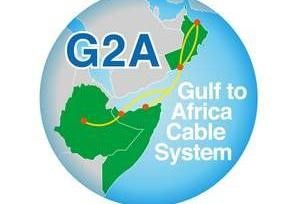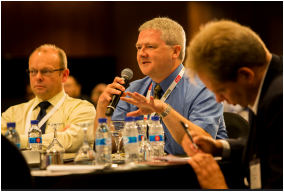|
Omantel, the national operator of Oman and the leading wholesale carrier in the Middle East, announced the signing of the supply agreement with Xtera Communications, Inc., a leading provider of high-capacity, cost-effective optical transport solutions, for building yet another unique submarine cable to strengthen its position in the region and beyond. The new cable will be built in partnership with Ethio Telecom, Golis Telecom, and Telesom Company, and will be a direct highway from Salalah in Oman to Bosaso in Puntland and Berbera in Somaliland, with a terrestrial extension to Addis Ababa in Ethiopia. Figure 5 - G2A Cable Map Source: G2A Consortium Press Release
"This is the first step on our expansion journey into Africa where we will go from Oman directly to Somalia and then extend the cable further into Africa to Ethiopia," said Sohail Qadir, Vice President Omantel Wholesale. "These two highly under-served countries will soon be connected to our international low-latency network, gain access to all the content hosted in Oman with Omantel and consume services from Europe and Southeast Asia," continued Mr. Qadir. G2A will be a new low-latency cable system with the purpose of bringing content closer to end-users in Africa and providing Somalia and Ethiopia with much needed Internet capacity and access to global cloud services and applications. The subsea part will run from Salalah, Oman, to both Bosaso in Somalia and Berbera in Somaliland. From Salalah, a terrestrial route through Oman will interconnect with all of Omantel's nine submarine cable systems, soon to be twelve, with some of them being the largest in the world connecting the Middle East with the Far East, Europe and North America. Omantel also hosts a wide range of content and cloud providers in Oman serving the Middle East region from their central hubs in Oman, all of which will be available to the G2A system. "This is a fascinating project, first of its kind, where we will benefit from Omantel's international network stretching around the globe to bring tremendous change in the region as access to high quality and affordable Internet services affects all aspects of peoples' lives and their way of thinking," said Mr. Abdikarim Mohamed Eid, CEO of Telesom Company. "At the same time we will gain access to the main Internet hubs in the world; the countries on Omantel's international network will become available through G2A to serve enterprise customers in Eastern Africa," added Mr. Andualem Admassie, CEO of Ethio Telecom. Xtera will supply its turnkey 100G/100G+ submarine cable system solution for this project, including subsea optical repeaters, Nu-Wave Optima™ Submarine Line Terminal Equipment (SLTE), cable, and all marine services. Xtera's subsea repeaters, engineered around a number of electrical, optical and mechanical innovations, use Raman optical amplification to produce very low noise levels for maximal repeater spacing and offer wide spectrum for higher system capacity. "We are extremely pleased to be selected by G2A consortium to build this new submarine cable system as a further validation of our turnkey offering of high-performance, high-reliability cable systems based on our innovative repeater," said Jon Hopper, President and Chief Executive Officer of Xtera. "This new build project is a perfect illustration of Xtera's innovative, flexible solutions for deploying new subsea infrastructure or upgrading existing cable assets under water." Designed for 20 Tbit/s of capacity with the latest 100G technology, the G2A system will optimize the connectivity costs in Africa and add much needed capacity to an under-served and fast growing region. "Today we are mainly relying on satellite communication for our Internet needs; G2A will dramatically change the end-user experience and enable new types of low-latency services both for the residential and corporate sectors," said Mr. Abdulaziz Gureye Karshe, Chairman of the Board of Golis. G2A will be ready for service in Q4-2016. Source: NASDAQ JRC ANALYSIS: According to a corresponding press release from Xtera, the drivers for this new system are:
G2A's submarine connection between Oman and Somaliland / Somalia by itself will probably not justify the investment because the addressable market is relatively small. It will be critical to construct the terrestrial connection to Addis Ababa, Ethiopia which represents a much larger and fast growing market. A glance at the map raises the question of why Ethiopia and Somaliland do not simply connect to Djibouti which is a hub for many existing and planned Europe-Asia cables (SEA-ME-WE-5, AAE-1, MENA/GBI, SEA-ME-WE-3, Tata TGN-Eurasia, EIG). As indicated above, the carriers involved in the G2A cable believe that they are not getting a good deal from these cables and the existing cross-border terrestrial connections into Djibouti are probably also vulnerable to damage. It is doubtful, however, that they will find Omantel, which is a member of three of the above-mentioned cable consortia, to be any more generous in providing onward connectivity to Europe and Asia. Finally, the RFS date of 4Q16 must be a typographical error. This system is around 2,000 km long. Xtera relies on Nexans or NSW for the repeatered cable used in its turnkey systems. This kind of system length would represent a substantial proportion of either company's annual production, especially considering the likely need for armoring along the proposed route which crosses one of the busiest shipping lanes in the world. After manufacture, the cable would have to be shipped from Europe, along with other components, including the Xtera repeaters. Cable landing stations would have to be built in challenging environments, and permitting will likely be breaking new ground with authorities that have no experience. The earliest that this system could be in place is some time in 2017.
0 Comments
Leave a Reply. |
Julian Rawle, AuthorThought leadership articles and commentary on developments related to the subsea fibre optic cable industry can be found here. Archives
February 2018
Categories |




 RSS Feed
RSS Feed